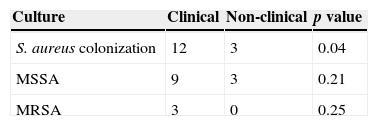Staphylococcus aureus is an epidemiologically important pathogen. Nasal colonization occurs in approximately 27% of healthy individuals. Methicillin-resistant S. aureus (MRSA) nasal colonization is increasing among the healthcare personnel in US hospitals, and the percentage of MRSA isolated from hospitals in Louisiana has almost doubled over the past decade.1 Although a variety of studies have examined the prevalence of nasal carriage of S. aureus and MRSA in diverse healthcare subpopulations (i.e., nurses, paramedics, and clerical workers), few studies in the United States have examined the potential contribution of medical students and graduate medical trainees who are exposed daily to a hospital environment as reservoirs for this bacteria.2,3 The aim of our study is to evaluate the nasal carriage rate of S. aureus in students and graduate medical trainees at a Louisiana health sciences center and to determine whether direct exposure to a hospital environment influences the prevalence of nasal S. aureus colonization rates.
Nasal swabs were collected from medical and graduate medical trainees with direct hospital exposure (clinical group, n=52). Controls without hospital exposure were selected from the graduate student and pre-clinical medical student populations (non-clinical group, n=42). All swabs were analyzed for presence of the methicillin-sensitive S. aureus (MSSA) and MRSA using standard microbiological techniques. Epidemiological information concerning risk factors for nasal carriage was obtained.
The mean age of participants was 28 years (range 19–44 years) with a male-to-female ratio of 2.4. There was no difference between the clinical and non-clinical groups in terms of previously identified risks factors for S. aureus carriage except for hospital exposure (p<0.0001). The clinical group had a significantly larger number of individuals colonized compared to the non-clinical group (p<0.05). Isolates from 3 of these individuals showed methicillin resistance (Table 1). Two of the subjects positive for MRSA were senior medical students, and one was a first year graduate medical trainee. All three had no additional risk factors for MRSA colonization. By comparison, none of the individuals in the non-clinical group tested positive for MRSA.
In our study, we demonstrated a low prevalence of MRSA among students at a health sciences center in Louisiana. However, exposure of these students to the hospital environment increased the prevalence of MRSA nasal colonization in this population from 0% to 3.2%. These findings are consistent with the only other previous report describing MRSA nasal carriage prevalence rates among healthy medical students in the United States with and without significant health-care-associated exposure (3.4% vs. 2.1%, respectively).2 However, our results diverged from the reported rates of S. aureus colonization rates among non-US medical students in their preclinical and clinical years. These studies, performed in the United Kingdom and Turkey, found that approximately 30% of the students were colonized with S. aureus in their clinical and non-clinical years.4,5 Awareness that healthy medical trainees can be reservoirs and contribute to the spread of these pathogenic bacteria will help us in understanding infection control especially during MRSA outbreaks.
Conflict of interestThe authors have no conflict of interest to declare.





